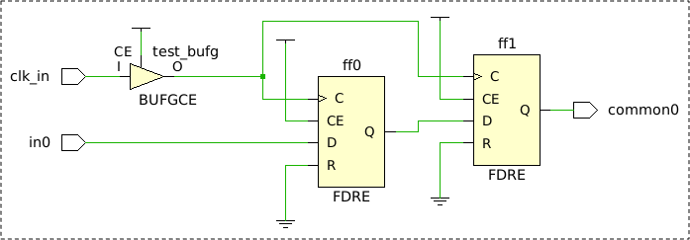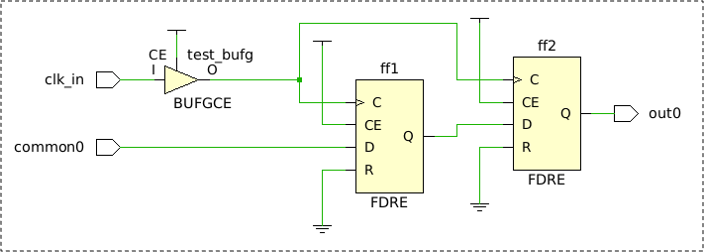Merging Designs¶
One useful technique in constructing an FPGA implementation is the ‘divide and conquer’ approach. When dividing a design, often, Vivado can achieve higher density and quality of results when it can focus on smaller parts of a design rather than the entire implementation at once.
After dividing a design into separate pieces, it can be tricky to re-assemble the components back into a cohesive implementation. The logical netlist must be consistent as well as the physical netlist. A popular approach is to separate the design by module hierarchy, implementing each module or cell out of context. However, not all designs benefit or have the right hierarchy necessary for this approach. To provide a more robust method of assembly, we have added a design merge capability in RapidWright.
Merging two or more designs in RapidWright can be accomplished with the API:
public static Design MergeDesign.mergeDesigns(Design ... designs);
Which uses Java’s variable argument construct (Varargs)
which can accept any Java Collection object (List<Design>,
Set<Design>, Collection<Design>) an array (Design[]) or a
simple comma separated list (design0, design1, ... , designN). The return value
is the resulting merged design which is the first design
passed as an argument (design0 in the comma separated list case). All other designs are destructively changed to
support the merge.
Customizing Merge Behavior¶
As there might be different valid ways to merge a design, the merge
process employs an AbstractDesignMerger to allow a user to implement
the desired merging behavior. There are five major object types that
must be resolved in a merge and they are captured in the abstract class
that inheritors must implement:
public abstract void mergePorts(EDIFPort p0, EDIFPort p1);
public abstract void mergeLogicalNets(EDIFNet n0, EDIFNet n1);
public abstract void mergeCellInsts(EDIFCellInst i0, EDIFCellInst i1);
public abstract void mergeSiteInsts(SiteInst s0, SiteInst s1);
public abstract void mergePhysicalNets(Net n0, Net n1);
The first three (EDIFPort, EDIFNet and EDIFCellInst) are all
logical netlist objects. The last two (SiteInst and Net) are
physical netlist objects. In the DefaultDesignMerger, a general
merge behavior is implemented. The order in which the objects are
merged is the same as that listed above. Here is a brief description
of the default merge behavior of the 5 object types in
DefaultDesignMerger.
Merging EDIFPorts¶
When merging ports, the two sets of ports on the top cell of both designs is examined. All names that are unique are merged into the resulting design. If both designs contain a port with the same name, the directionality of the ports is checked. If they are of opposite directionality (one is an input and the other an output), generally both ports will be removed and their connected nets will be joined. The net attached to the input port will be eliminated and the net on the output port will assume the sinks of the input port.
If both ports are inputs, the extra copy is removed and its sinks are added to the first design’s port. If both ports are outputs, the same approach is taken except if the merging is incompatible (two different sources that cannot be merged), an error will be thrown.
Merging EDIFNets (Logical)¶
All unique nets are included in the merged design. If each input design has a net with the same name, sinks are moved from one copy to the merged net. If one net has a top level port source and the other has a real (hard cell pin) source, the merging will choose the real source to be included in the final merged net and the port will be omitted.
Merging EDIFCellInsts¶
All unique instances are included in the merged design. When two designs contain instances of the same name, only one is kept. Each of the pins on both copies of the instance are examined, if one of the ports is unconnected or undriven, it will use the connection from the other source design. If both copies of a pin are driven by a source or connection that cannot be merged, an error is thrown.
To illustrate an example of some of these merging concepts, consider
the following two designs, Design A and Design B:

Input Design A¶

Input Design B¶
If Design A and Design B were merged using the RapidWright
API, the resulting design would be:

Result of Merging Design A and Design B¶
Merging SiteInsts¶
Generally, if a merging of two or more designs are attempted, their implementation should not overlap unless curated in a predictable manner. Merging more than one SiteInst from two different sources both placed onto the same site can be complicated and error prone. The merge API will attempt to merge placed cells and site routing even if they occupy the same site.
Merging Nets (Physical)¶
All unique physical nets are merged in the final result. If more than one copy of a physical net exists in the design inputs, the routing is combined simply by taking the union of the PIPs belonging to each copy. GND and VCC are common cases where the physical net is merged.